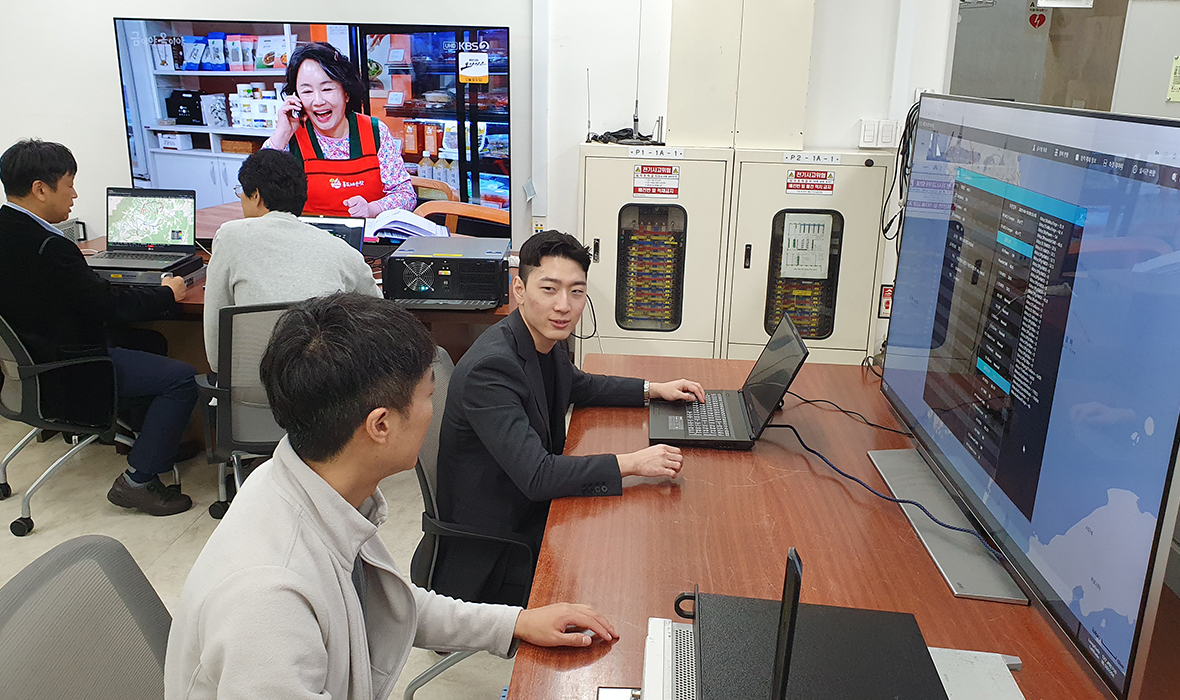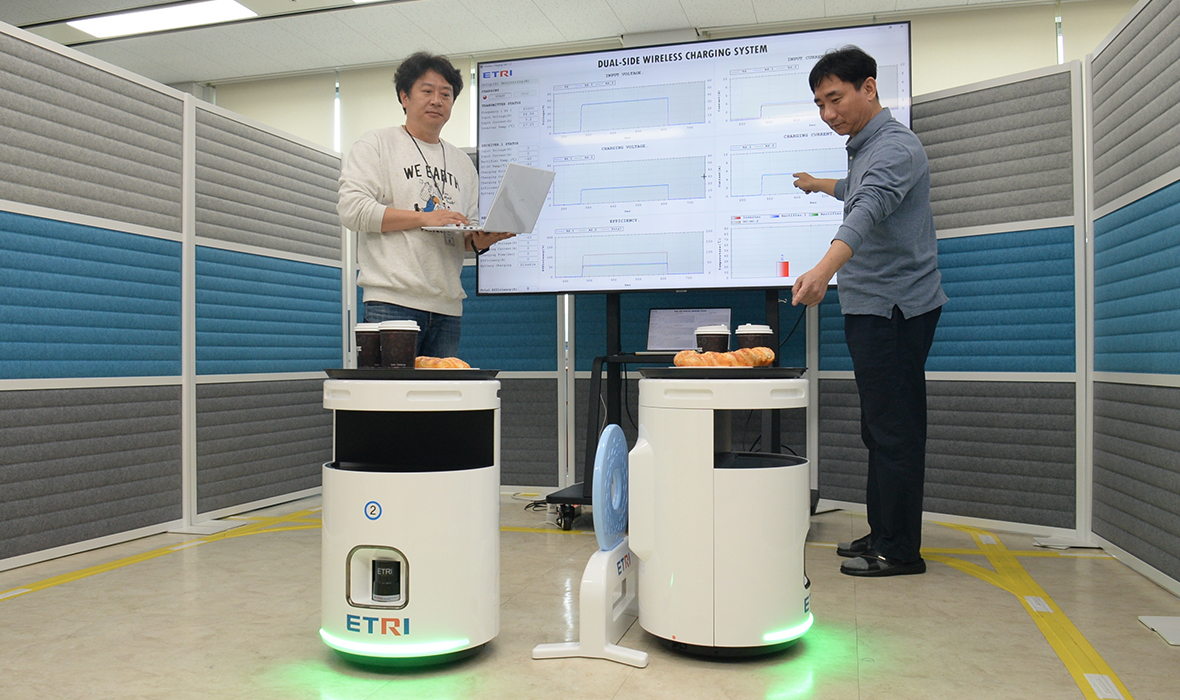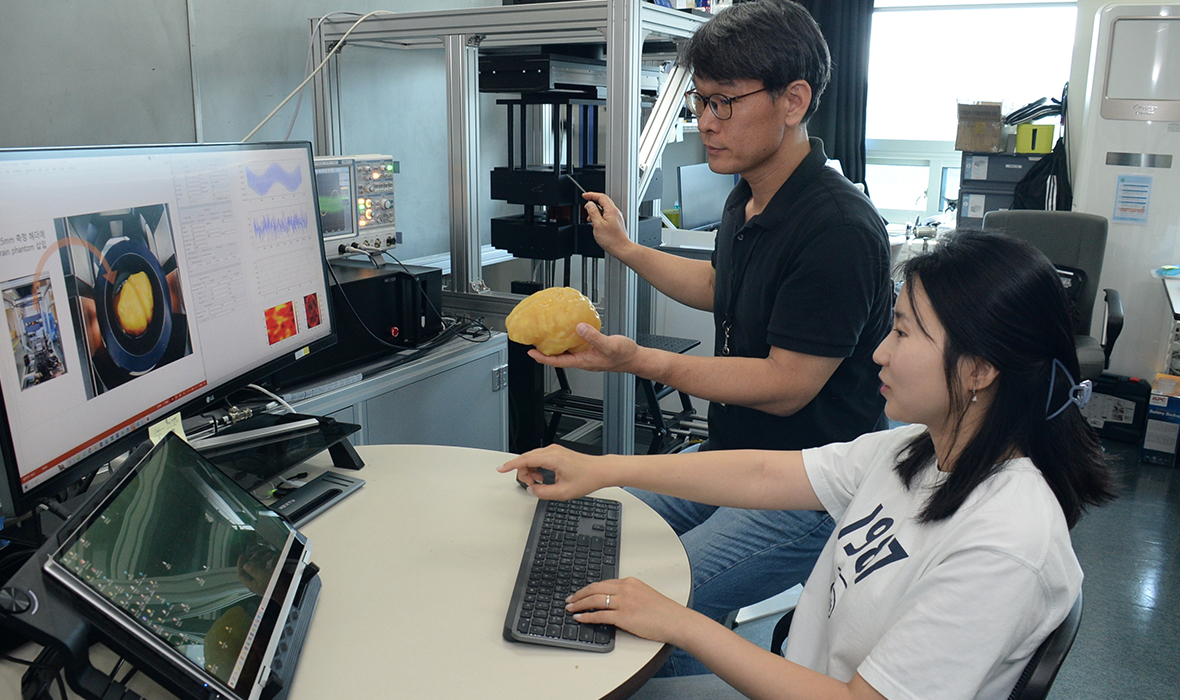
News
Vol.73
NEWS 1
ETRI presents ‘Future UHD Broadcasting’ at NAB show
- Demonstrated backward-compatible MIMO and UHD/HD simultaneous delivery technologies
- Verified ultimate ultra-high definition with UHD core technology and 5G transmission/reception technology
※ Hyper-Reality Metaverse Research Laboratory, Media Research Division, Media Broadcasting Research Section

Electronics and Telecommunications Research Institute(ETRI) participated in the world’s largest ‘National Association of Broadcasters(NAB) show 2023’ held at the Las Vegas Convention Center in the United States for four days from April 16th and exhibited the state-of-the-art UHD broadcasting and 5G convergence transmission/reception broadcasting technologies.
The technologies that ETRI unveiled together with Korean broadcasting equipment makers at this exhibition are the North American Digital Broadcasting Standardization Organization(ATSC*) 3.0-based technologies. It has high industrial applicability, and there is a huge potential that it will expand worldwide beyond North America in the future.
The exhibited technologies are core technologies to efficiently provide UHD broadcasting services such as ▲MIMO** transmission system that supports backward-compatibility ▲Integrated Master Antenna TV system that provides UHD and HD services at the same time ▲5G-MBMS*** convergence transmission/reception system that provides terrestrial broadcasting services to multiple users.
The technologies showcased through this exhibition are purely proprietary technologies developed by ETRI through joint research with Korean broadcasting equipment companies such as KBS, Cleverlogic, KaiMedia, Agos, and Lowasis. This is expected to be of great help in building technological capabilities that lead the Korean broadcasting industry and enhancing international competitiveness.
Madeleine Noland, Chairman of ATSC, said, “Among the technologies ETRI showcased at NAB show 2023, the ATSC 3.0-based MIMO transmission system supporting backward-compatibility and the ATSC 3.0/5G-MBMS convergence transmission/reception system are innovative technologies that suggest the direction of future broadcasting.”
In 2015, ETRI won the NAB ‘Technology Innovation Award’ and the Institute of Electrical and Electronic Engineers(IEEE) Best Journal Paper Award for the development of mobile HD and 4K-UHD simultaneous transmission technology. In addition, in 2021, ETRI produced IEEE Fellow(Dr. Park Sung-ik) and continues to lead the global broadcasting technology.
* Standardization organization that establishes standards for terrestrial digital broadcasting in North America(ATSC: Advanced Television Systems Committee)
** MIMO (multiple-input and multiple-output): A technology that doubles the transmission capacity of an existing channel without adding frequency resources by applying two antennas vertically and horizontally to each transmitter and receiver
*** Multimedia Broadcast and Multicast Service: Terrestrial media service technology of the 3GPP communication standard
Jae Hyun Seo, Director
Media Broadcasting Research Section
(+82-42-860-4869 jhseo@etri.re.kr)
NEWS 2
Wireless charging of two robots at the same time
- World’s first development of coil bi-directional simultaneous wireless charging technology
- Maximization of wireless charging space efficiency and price reduction effect
- It is expected to revitalize the wireless charging robot market such as restaurant serving and logistics
※ Terrestrial & Non-Terrestrial Integrated Telecommunications Research Laboratory, EM Wave Basic Technology Research Section

Wireless charging technology is applied to various fields such as smartphones, electric vehicles, and robots, but currently it is a 1:1 charging method in which one transmitter charges one receiver. ETRI has solved this problem that hindered the vitalization of the technology.
Electronics and Telecommunications Research Institute(ETRI) announced that it has succeeded in developing the world’s first “dual-side robot wireless charging” technology that enables simultaneous wireless charging in both directions of the transmitting coil using one transmitting coil* that is the same size as the receiving coil.
The dual-side robot wireless charging technology developed by the research team is capable of wirelessly charging two robots at the same time with 50 watts(W) each, fully charging the robots within an hour.
Until now, in order to simultaneously charge two receivers, it was necessary to create a magnetic field using a transmission coil larger than the receiver. However, this has been a spatial and economic constraint for wireless charging.
The dual-side robot wireless charging technology developed by the research team uses both sides of a 20 cm diameter coin-shaped transmitting coil placed vertically on the ground to wirelessly charge two robots at the same time. As a result, the system price can be significantly reduced compared to the existing 1:1 wireless charging technology.
The research team explained that they developed a wireless charging system with the world’s best transmission distance and performance by realizing a transmission distance of 7 cm and a high efficiency of 90 % or higher using a coil with a diameter of 20 cm.
In the future, the ETRI research team will expand this achievement, which can charge two robots simultaneously, planning to develop a cluster robot wireless charging system that can charge up to six service robots simultaneously with one transmitter, and multiple power control technology that can respond to various charging environments, to enhance the completeness of the wireless charging system.
* Receiving coil, transmitting coil: serves as an antenna for generating, transmitting, and receiving magnetic fields as the smallest component of magnetic field wireless charging.
Seong-Min Kim, Principal Researcher
EM Wave Basic Technology Research Section
(+82-42-860-1687, smkim97@etri.re.kr)
NEWS 3
Radiation-safe brain tumor detection technology development
- Securing human body applicability with the world’s largest 125 mm MPI technology
- Using iron oxide nanoparticles that is harmless to the human body, diagnosing diseases without worrying about radiation
※ Superintelligence Creative Research Laboratory, Field Robotics Research Section

A research team in Korea has developed a cutting-edge technology to replace positron tomography(PET), one of the medical imaging techniques used to find cancer or specific diseases, further enhancing the possibility of application to the human body. It is expected to be of great help in improving the health of the people and strengthening competitiveness in the medical imaging market in the future.
Electronics and Telecommunications Research Institute(ETRI) announced that it succeeded in developing imaging equipment with the world's largest Field of view(FOV*) of 125mm using medical imaging(MPI**) technology using iron oxide nanoparticles.
Computed tomography(CT) or magnetic resonance imaging(MRI), which are most commonly used among imaging diagnostic equipment, diagnoses structural abnormalities in the human body. On the other hand, PET has the advantage of diagnosing biochemical and functional abnormalities in biological tissues in the human body and can be used in various fields such as diagnosis of cancer and brain tumors and early diagnosis of dementia.
However, the biggest problem with PET is that the patient must ingest the radiopharmaceutical***. Although it is a very small amount, radioactive materials enter the human body, so internal exposure is made, and accordingly, there are many restrictions depending on the number of tests and the patient’s physical condition.
The technology developed by ETRI can replace PET by utilizing iron oxide nanoparticles that are harmless to the human body. Iron oxide nanoparticles are harmless to the human body and can be used continuously, so they are expected to be effective for tracking and early diagnosis of chronic diseases.
Following the development of 40 mm MPI equipment in 2019, the research team succeeded in developing equipment with a 125 mm field of view(FOV) this year. With frequency mixing magnetic detection (FMMD****) technology and magnetic field-type MPI technology using a permanent magnet array, it secured the world's largest field of view (FOV), taking a step closer to application to the human body in the future.
The research team independently developed most of the original technologies required for the equipment, including the magnetic field generator, central control system, and control SW. In addition, the diameter is 125 mm, which is three times the size of the existing equipment, and it is a size that can be applied to the living body using small animals such as rabbits as well as laboratory mice.
* Field of View: Viewing angle
** MPI(Magnetic Particle Imaging): Medical imaging technology using nanometer-sized iron oxide particles
*** Radiopharmaceuticals that emit positrons
**** FMMD(Frequency Mixing Magnetic Detection)
Jeong Jaechan, Senior Researcher
Field Robotics Research Section
(+82-42-860-6116, channij80@etri.re.kr)